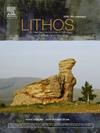Unraveling the polymetamorphism of calc-silicate rocks from 639 to 561 Ma in the Western Gondwana (Passo Feio Complex, Dom Feliciano Belt, South Brazil) based on U-Pb dating in titanite, apatite and zircon
IF 2.9
2区 地球科学
Q2 GEOCHEMISTRY & GEOPHYSICS
引用次数: 0
Abstract
Titanite is a valuable tool for studying polymetamorphism and understanding the evolution of orogenic belts as it potentially records different stages of metamorphic evolution. The combination of geochronology and Zr-in-titanite geothermometry has been widely used in petrochronology studies. However, there is ongoing debate regarding the significance of ages and temperatures obtained from titanite. Here, we conducted the first integrated titanite, zircon, and apatite U![]() Pb study, along with Zr-in-titanite geothermometry, on calc-silicate rocks from a polymetamorphic complex of the central Dom Feliciano Belt (Western Gondwana). Our aim was to investigate the impact of various metamorphic events on titanite grains. We carried out a geochronological, geochemical, and petrographic analysis of a calc-silicate sequence of the Passo Feio Complex, which was intruded by the Caçapava do Sul Granitic Complex (CSGC). The metamorphic complex experienced regional, contact, and hydrothermal metamorphism during the Neoproterozoic, but the ages and conditions of these metamorphic events remain widely debated. U
Pb study, along with Zr-in-titanite geothermometry, on calc-silicate rocks from a polymetamorphic complex of the central Dom Feliciano Belt (Western Gondwana). Our aim was to investigate the impact of various metamorphic events on titanite grains. We carried out a geochronological, geochemical, and petrographic analysis of a calc-silicate sequence of the Passo Feio Complex, which was intruded by the Caçapava do Sul Granitic Complex (CSGC). The metamorphic complex experienced regional, contact, and hydrothermal metamorphism during the Neoproterozoic, but the ages and conditions of these metamorphic events remain widely debated. U![]() Pb analyses on over one hundred titanite grains from a K-feldspar-diopside schist revealed three distinct titanite populations. The older group, dated at 639 ± 3/7 Ma (2s; n = 19), was associated with the regional metamorphism event (M1), likely initiated by the primary collision of the Dom Feliciano Belt. The intermediate group exhibited an age of 596 ± 1/6 Ma (2s; n = 91). Given the presence of high-K magmatism and a carbonatite intrusion in the study area, producing zircon U
Pb analyses on over one hundred titanite grains from a K-feldspar-diopside schist revealed three distinct titanite populations. The older group, dated at 639 ± 3/7 Ma (2s; n = 19), was associated with the regional metamorphism event (M1), likely initiated by the primary collision of the Dom Feliciano Belt. The intermediate group exhibited an age of 596 ± 1/6 Ma (2s; n = 91). Given the presence of high-K magmatism and a carbonatite intrusion in the study area, producing zircon U![]() Pb ages around 600 Ma, this group was associated with contact metamorphism (M2), belike influenced by these intrusive igneous activities. The youngest titanite population showed an age of 566 ± 3/6 Ma (2s; n = 6), which closely aligns, within analytical error, with the age of 561 ± 1/6 Ma (2s; n = 46) obtained from U
Pb ages around 600 Ma, this group was associated with contact metamorphism (M2), belike influenced by these intrusive igneous activities. The youngest titanite population showed an age of 566 ± 3/6 Ma (2s; n = 6), which closely aligns, within analytical error, with the age of 561 ± 1/6 Ma (2s; n = 46) obtained from U![]() Pb dating on apatite sourced from a diopside-phlogopite schist. The younger ages observed in both titanite and apatite are attributed to alterations resulting from interactions with hydrothermal fluids (M3) during the cooling phase of the CSGC. Chemical analyses conducted with an electron microprobe assessed the Zr concentrations in fifty titanite grains, examining both bright and dark zones observed in back-scattered electron images. The lowest temperature recorded among the 50 grains was 629 °C, which corresponds to dark BSE zones. In the light zones, the minimum temperature was 639 °C. While temperatures estimated using the Zr content in titanite may not correspond precisely with U
Pb dating on apatite sourced from a diopside-phlogopite schist. The younger ages observed in both titanite and apatite are attributed to alterations resulting from interactions with hydrothermal fluids (M3) during the cooling phase of the CSGC. Chemical analyses conducted with an electron microprobe assessed the Zr concentrations in fifty titanite grains, examining both bright and dark zones observed in back-scattered electron images. The lowest temperature recorded among the 50 grains was 629 °C, which corresponds to dark BSE zones. In the light zones, the minimum temperature was 639 °C. While temperatures estimated using the Zr content in titanite may not correspond precisely with U![]() Pb ages, combining titanite ages with those from other accessory minerals like zircon and apatite, along with microstructural analysis, can provide a more comprehensive understanding of orogenic belt evolution.
Pb ages, combining titanite ages with those from other accessory minerals like zircon and apatite, along with microstructural analysis, can provide a more comprehensive understanding of orogenic belt evolution.
基于榍石、磷灰石和锆石的U-Pb年代测定,揭示西冈瓦纳(巴西南部Dom Feliciano带Passo Feio复合体)钙硅酸盐岩从639 Ma到561 Ma的多变质作用
榍石是研究多变质作用和了解造山带演化的重要工具,因为它可能记录变质演化的不同阶段。在岩石年代学研究中,地球年代学与钛铁矿中锆元素地热测定法的结合得到了广泛应用。然而,关于从榍石中获得的年龄和温度的意义一直存在争议。在这里,我们首次对来自Dom Feliciano带(西冈瓦纳)中部多变质复合体的钙硅酸盐岩进行了榍石、锆石和磷灰石UPb综合研究以及钛铁矿中Zr地温测定法。我们的目的是研究各种变质事件对榍石晶粒的影响。我们对被南卡萨帕瓦花岗岩群(CSGC)侵入的 Passo Feio 复合体的钙硅酸盐序列进行了地质年代、地球化学和岩石学分析。该变质复合体在新近纪经历了区域变质、接触变质和热液变质,但这些变质事件的年龄和条件仍存在广泛争议。对来自K-长石-透辉石片岩的一百多颗榍石晶粒进行的UPb分析表明,榍石有三个不同的族群。年代较早的一组为 639 ± 3/7 Ma (2s; n = 19),与区域变质事件(M1)有关,可能是由 Dom Feliciano 带的初级碰撞引发的。中间组的年龄为 596 ± 1/6 Ma(2s;n = 91)。鉴于研究区域存在高K岩浆活动和碳酸盐岩侵入,产生了约600 Ma的锆石UPb年龄,该组与接触变质作用(M2)有关,可能受到这些侵入火成岩活动的影响。最年轻的榍石群显示的年龄为 566 ± 3/6 Ma (2s; n = 6),在分析误差范围内,与来自透辉石片岩的磷灰石的 UPb 年龄 561 ± 1/6 Ma (2s; n = 46) 非常接近。在榍石和磷灰石中观察到的较年轻的年龄归因于在CSGC冷却阶段与热液(M3)相互作用所产生的变化。利用电子显微镜进行的化学分析评估了 50 个榍石晶粒中的锆浓度,检查了在背散射电子图像中观察到的亮区和暗区。在这 50 个晶粒中,记录到的最低温度为 629 °C,与 BSE 暗区相对应。在亮区,最低温度为 639 ℃。虽然利用榍石中的锆含量估算的温度可能与 UPb 年龄不完全一致,但将榍石年龄与锆石和磷灰石等其他附属矿物的年龄结合起来,再加上微结构分析,可以更全面地了解造山带的演化。
本文章由计算机程序翻译,如有差异,请以英文原文为准。
求助全文
约1分钟内获得全文
求助全文
来源期刊

Lithos
地学-地球化学与地球物理
CiteScore
6.80
自引率
11.40%
发文量
286
审稿时长
3.5 months
期刊介绍:
Lithos publishes original research papers on the petrology, geochemistry and petrogenesis of igneous and metamorphic rocks. Papers on mineralogy/mineral physics related to petrology and petrogenetic problems are also welcomed.
 求助内容:
求助内容: 应助结果提醒方式:
应助结果提醒方式:


